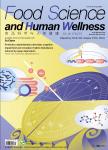Quantification and discovery of PCR inhibitors found in food matrices commonly associated with foodborne viruses
Quantification and discovery of PCR inhibitors found in food matrices commonly associated with foodborne viruses作者机构:Department of Food ScienceUniversity of MassachusettsAmherstMA 01003United States
出 版 物:《Food Science and Human Wellness》 (食品科学与人类健康(英文))
年 卷 期:2019年第8卷第4期
页 面:351-355页
核心收录:
学科分类:0832[工学-食品科学与工程(可授工学、农学学位)] 1004[医学-公共卫生与预防医学(可授医学、理学学位)] 09[农学] 0903[农学-农业资源与环境]
基 金:This project was funded by the University of MassachusettsAmherst
主 题:PCR inhibition PCR false negatives Norovirus detection Hemocyanin Pectin
摘 要:Human norovirus is the leading cause of foodborne illness *** and quantification of norovirus commonly involves the use of reverse transcriptase quantitative polymerase chain reaction(RT-qPCR);however,the presence of inhibitory compounds in foods limit detection and accurate *** some studies have been done on PCR inhibitors from foods,many of them are over a decade old and do not investigate inhibition in contemporary one-step RT-qPCR-based detection *** purpose of this work was to quantify the degree of inhibition that occurs from inhibitory compounds found in produce(pectin)and mollusks(hemocyanin,glycogen)—foods commonly associated with norovirus ***-qPCR reactions containing different amounts of genomic bacteriophage MS2 RNA,a norovirus surrogate,were spiked with different concentrations of pectin(0.0625%–0.25%w/V),glycogen(1.25%–10%),and hemocyanin(0.0625%–0.25%).Past research has implicated glycogen as an inhibitory compound in oysters;however,even high levels of glycogen(10%)had no significant effect(P0.05)on ***,both pectin and hemocyanin caused complete inhibition at 0.25%,with no significant inhibition observed at 0.0625%(P0.05).Hemocyanin is abundant in the hemolymph of mollusks and previously untested as a PCR *** work demonstrates that pectin and hemocyanin should be considered when testing produce and mollusk samples with PCR-based methods.



